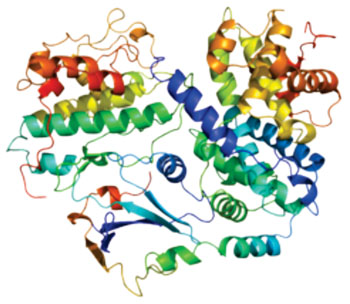Keratin 17 Oncoprotein Potential Cervical Cancer Biomarker
By LabMedica International staff writers
Posted on 22 Sep 2015
The keratin protein K17 (Keratin 17), which was thought to play a purely passive mechanical support role for tumors, has been shown to act as a cancer-promoting oncoprotein whose expression by cervical cancer cells is linked to decreased likelihood of survival.Posted on 22 Sep 2015
Investigators at Stony Brook University (NY, USA) studied the mechanistic basis for the biologic impact of K17 through loss- and gain-of-function experiments in human cervix, breast, and pancreatic cancer cells.

Image: Model of the p27KIP1 (cyclin-dependent kinase inhibitor 1B) protein (Photo courtesy of Wikimedia Commons).
They reported in the September 1, 2015, issue of the journal Cancer Research that K17 functioned as an oncoprotein by regulating the subcellular localization and degradation of p27KIP1 (cyclin-dependent kinase inhibitor 1B). K17 was released from intermediate filaments and translocated into the nucleus via a nuclear localization signal (NLS), specific among keratins, where it bound p27KIP1 (P27) during G1 phase of the cell cycle.
The p27 protein is considered a tumor suppressor because of its function as a regulator of the cell cycle. In cancers it is often inactivated via impaired synthesis, accelerated degradation, or mislocalization. These act to accelerate the proteolysis of the p27 protein and allow the cancer cell to undergo rapid division and uncontrolled proliferation.
Cervical cancer cells expressing K17 mutations exhibited an increase in levels of nuclear p27KIP1, whereas cells expressing wild-type K17 exhibited depletion in total endogenous p27KIP1. In cervical cancer clinical specimens, the expressions of K17 and p27KIP1 were inversely correlated, both across tumors and within individual tumors. Thus, K17 mediated cancer cell-cycle progression and tumor growth by promoting p27KIP1 nuclear export and degradation.
“These findings explain to a certain extent why cancer patients without K17 expression have twice the chance of surviving from this disease compared to patients who express K17,” said senior author Dr. Kenneth Shroyer, professor of pathology at Stony Brook University. “However, it is likely that K17 may also play other important roles in cancer that extend far beyond its interaction with p27.”
“Overall, these results suggest that K17 could be used as a biomarker to distinguish between clinically identical patients, identifying cases that are more aggressive at the time of diagnosis and potentially guiding personalized treatment based on individual K17 status,” said Dr. Shroyer.
Related Links:
Stony Brook University













.jpg)